|
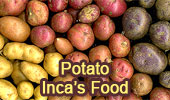
Potato Inca's Food
As Other Staples Soar, Potatoes Break New Ground.
Hiram Bingham, the American explorer who found the
ruins of Machu Picchu in 1911, wrote:
To the Incas the art of agriculture was of
supreme interest. They carried it to a remarkable extreme, attaching
more importance to it than we do to-day. They not only developed many
different plants for food and medicinal purposes, but they understood
thoroughly the cultivation of the soil, the art of proper drainage,
correct methods of irrigation, and soil conservation by means of
terraces constructed at great expense. Most of the agricultural fields
in the Peruvian Andes are not natural. The soil has been assembled, put
in place artificially, and still remains fertile after centuries of use.
The Incas learned the importance of
fertilizers to keep the soil rich and fruitful. They had discovered the
value of the guano found on the bird-islands that lie off the coast of
Peru, setting aside various of these islands for the benefit of
different provinces. No one was allowed to visit the islands during the
breeding season. Although hundreds of thousands of fish-eating birds
inhabit the islands, the Incas punished by death anyone killing a single
guano-producing bird.
They depended on terrace agriculture. It is
seen in its most conspicuous form on steep slopes. Terraces are found in
many other countries, notably in east Asia and the Philippines, but it
is very doubtful whether any equal those constructed by the Incas. In
Peru the artificial reconstruction of the surface soil was not limited
to slopes, but was also undertaken in large areas of reclaimed land in
valley bottoms. They even narrowed and straightened the courses of the
rivers, filled in the land behind strong walls and topped off the work
with a surface layer of fine soil.
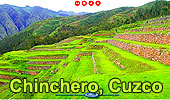
The system of terrace agriculture which they
developed consists roughly of three parts, the retaining wall and two
distinct layers of earth that fill the space behind the wall. The
underlying stratum, an artificial sub-soil, is composed of coarse stones
and clay to a thickness that depends upon the height of the retaining
wall. This stratum was covered by a layer of rich soil two or three feet
deep.
Fortunately for the Incas the soils in the
terraced districts are tenacious and not readily eroded. A few sods or a
small ridge of earth will hold in check a stream of water, thus greatly
facilitating the irrigation of the terraces. In places, large stones
deeply grooved lengthwise served as spouts to carry the water out from a
terrace wall thus avoiding the danger of erosion or undermining.
Mr. O. F. Cook, the distinguished authority
on tropical agriculture who was the botanist on one of my Peruvian
expeditions, tells me that the Incas and their predecessors domesticated
more kinds of food and medicinal plants than any other people in the
world.
They found a small plant growing in the high
Andes, with a tuberous root about the size of a small pea. It proved to
be edible and from it, in the course of the centuries, they finally
developed a dozen varieties of what we call the "Irish" or white potato,
suitable for cultivation at elevations varying from sea level to
fourteen thousand feet above it. After the Spanish Conquest of Peru, it
took Europeans nearly three centuries to appreciate the staple food of
the Incas. In fact, had it nit been for famines in France and Ireland it
is hard to say when the Peruvian potato would have been accepted as part
of their daily ration.
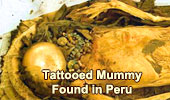
The skill and ingenuity of the Inca
agriculturists was shown not only in the breeding and raising of many
kinds of potatoes, but also in the very many varieties of maize or
Indian corn, suitable for cultivation at varying elevations, which they
developed. No one knows exactly the plant from which maize was
originally derived. There is no doubt, however, that the Incas had more
varieties of maize, a whole series that were unlike any that are known
from Central America or Mexico, and had gone to a far greater extreme in
developing them than did the Mayas.
An Inca food plant almost unknown to
Europeans is canihua, a kind of pig weed. It is harvested in
April, the stalks are dried and placed on a large blanket laid on the
ground as a threshing floor. The blanket serves to prevent the small
greyish seeds from escaping when the flail is applied.
Another unfamiliar food plant, also a
species of pig weed, is called quinoa. Growing readily on the
slopes of the high Andes at an elevation as great as most of our Rocky
Mountains it manages to attain a height of three or four feet and
produces abundant crops. The seeds are cooked like a cereal and are very
palatable.
At lower elevations in the Andes the Incas
developed another series of root crops, most of which are still
unfamiliar to us, but one, the sweet potato, has achieved world-wide
popularity.
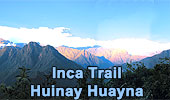
In addition to discovering and developing
useful food plants, the Incas also were the first to learn the
advantages of certain medicinal herbs, particularly quinine, long known
as a specific in the cure of malaria. They also discovered the specific
effects of cocaine, which is extracted from coca leaves, but only
allowed it to be used by those engaged in such strenuous activities as
the marathons of their post runners. Judging by the "medicines" sold by
the Indian "druggists" who display their wares in the market places of
the mountain towns, the ancient remedies included such minerals as
sulphur, such vegetables as the seeds, roots, and dried leaves of
tropical jungle plants, and such animals as star-fish!
Source:
‘Lost City of the Incas, The Story of Machu
Picchu and its Builders’ by Hiram Bingham
The American explorer who found the ruins of Machu Picchu in 1911.
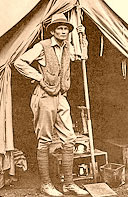
Hiram Bingham at Machu Picchu
The inspiration for Indiana Jones?
|